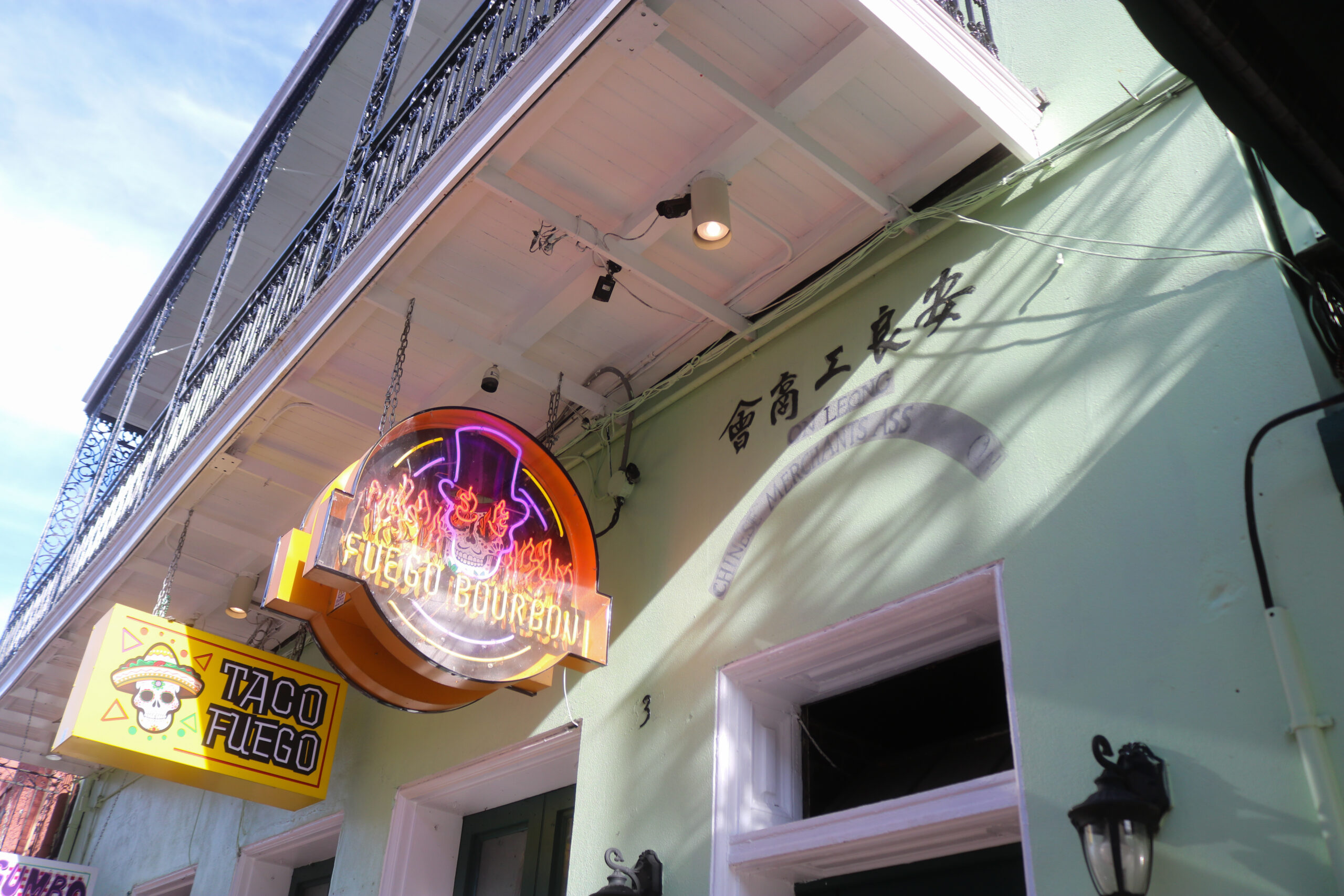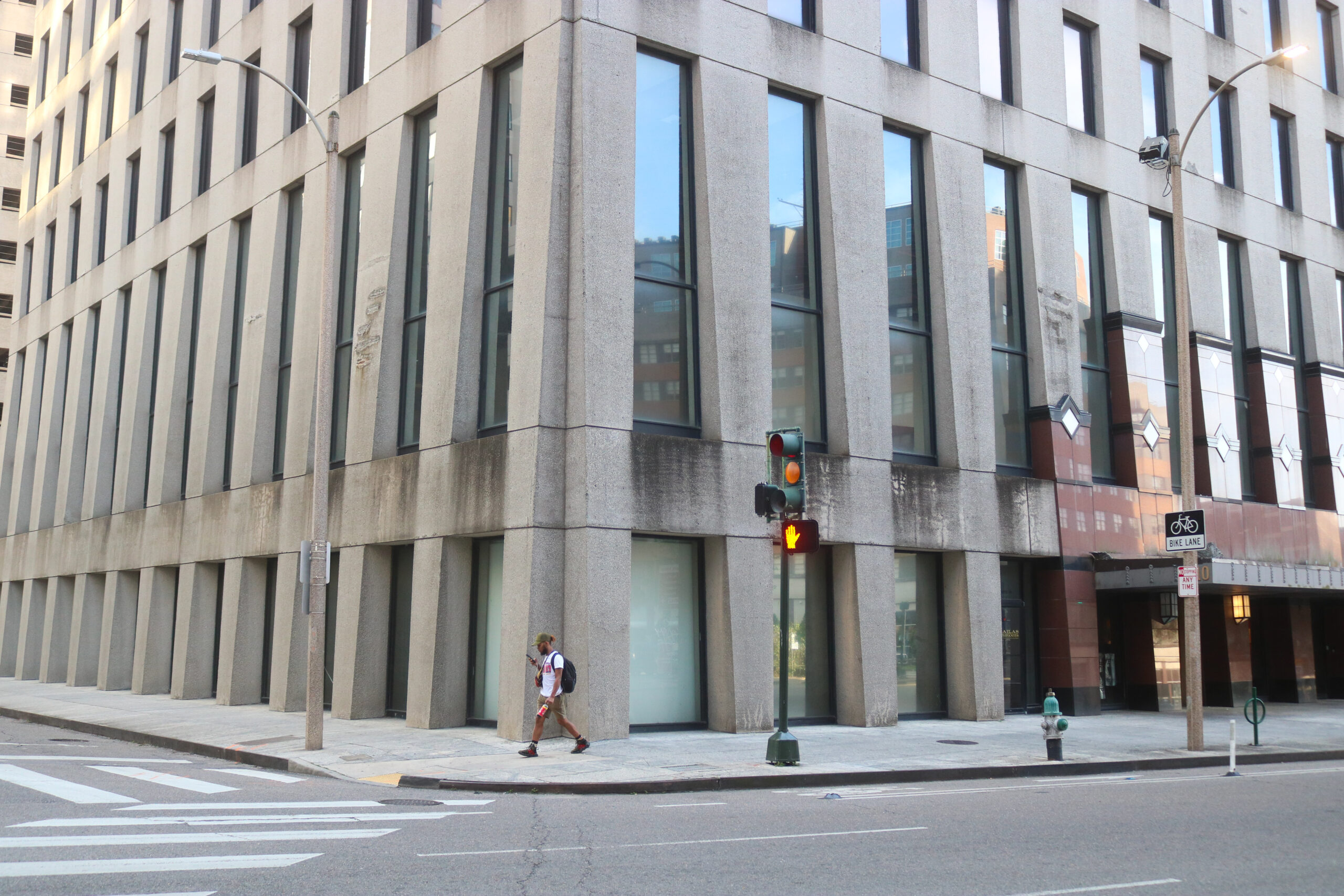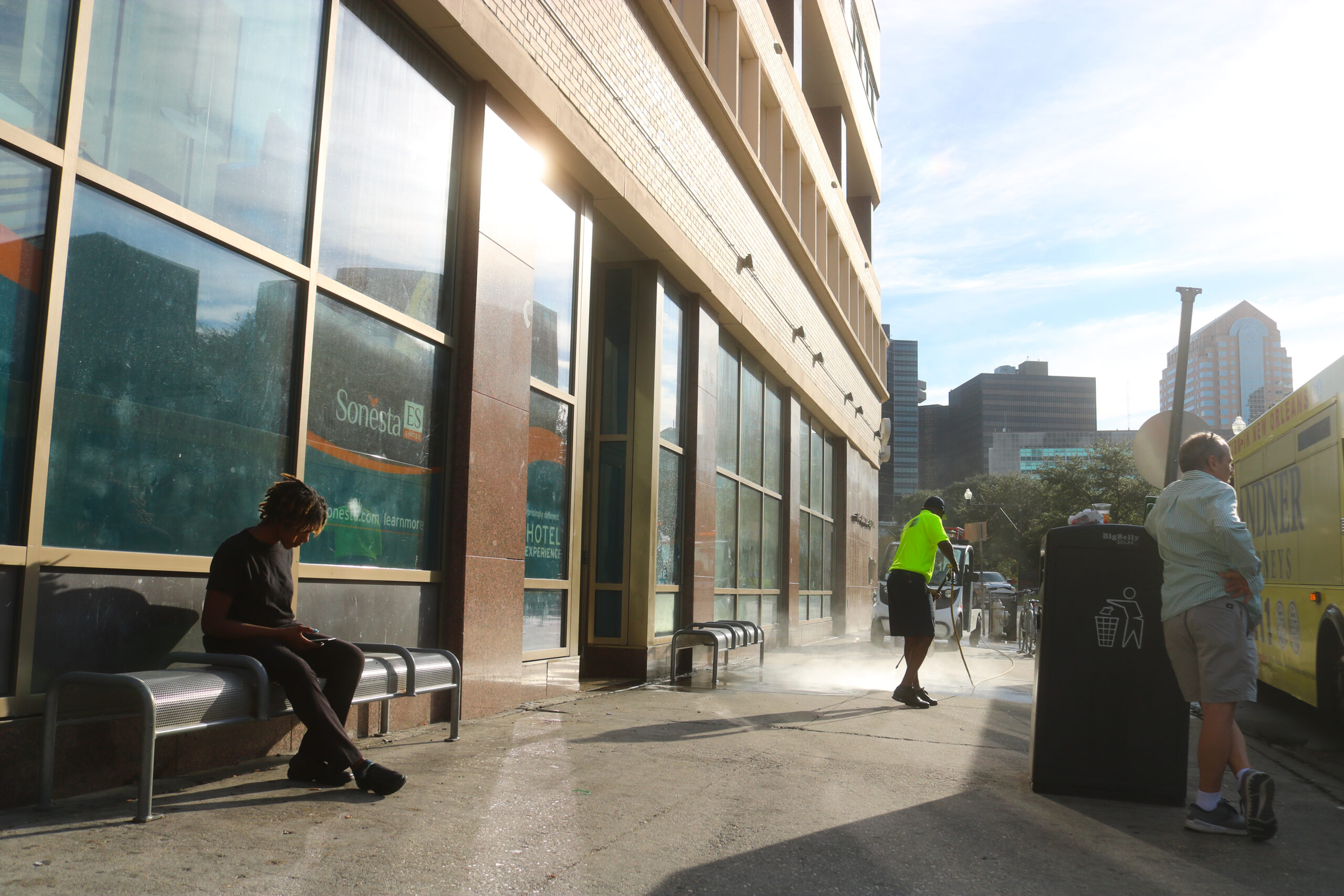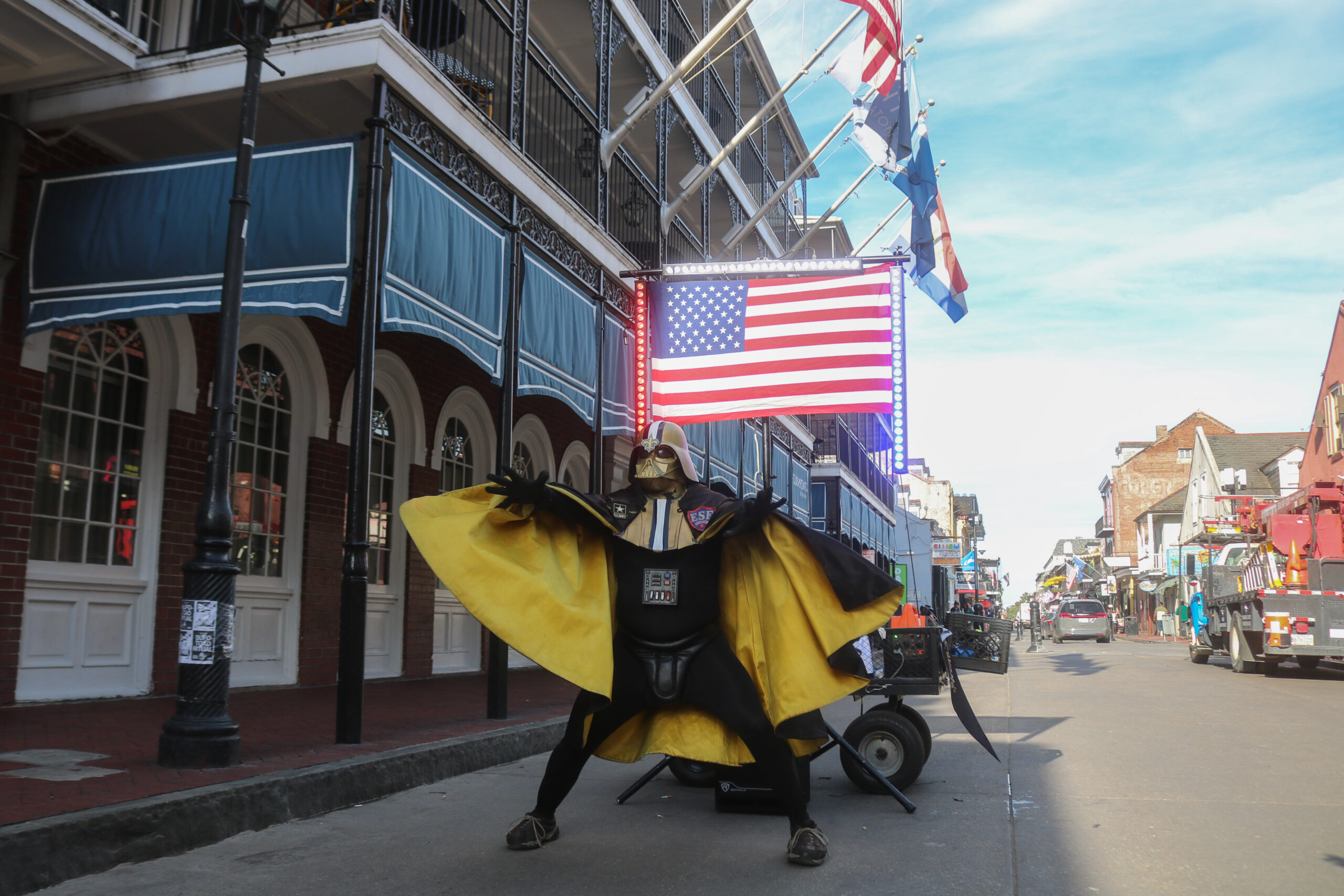Heading east on Bourbon Street, a very patriotic Darth Vader, donned in Saints colors, vigorously lip syncs to Lee Greenwood’s “God Bless the U.S.A.” in front of an American flag. It’s 3 pm on a Wednesday, and the triumphant melody fills the otherwise quiet block. He gives his best impression of a rock star, hips thrusting and hands reaching towards the sky, before closing into a determined fist as he shakes with faux desperation. If Darth Vader weren’t wearing his mask, one might see veins popping from his forehead. His act on Bourbon Street – with his pop culture references, cheap costume, and gaudy performance skills – is as faux as some deem Bourbon Street itself.
Despite such examples of Bourbon Street’s cheap “authenticity” against the backdrop of historic architecture, there is one piece of true historical cultural preservation to seek out, within range of Greenwood’s voice booming from a set of speakers. Walking the two blocks, from the crossroad of St. Louis to the crossroad of St. Peter, takes you through the meager Chinatown that once existed on the 500 block of this internationally famous street.
Today, however, there is no trace of any Chinese businesses. The blocks are lined with gift shops, daiquiri and pizza shops, and clubs. To see anything past the brightly colored and neon signs hanging from balconies, a tourist would have to be paying attention. Now, walking west on the other side of the street, back toward Darth Vader, it begins to feel like Chinatown really has been completely erased. But pass a sign for Taco Fuego, a sign for Fuego Bourbon, and then look up fast, before you miss it. On the light green wall above a doorway, black Chinese characters sit above gray-painted lettering that reads “On Leong Chinese Merchants Association.” As the lyrics “I’m proud to be an American, where at least I know I’m free” float up and down these two blocks of Bourbon, the last indication of Chinatown’s existence sits like a fly on the wall, its paint contining to fade.
 If you are surprised to learn about a former Chinatown in New Orleans, you are not alone; nearly everybody is. The truth is that the Chinatown on Bourbon Street was more like a collection of 10 to a dozen businesses scattered between St. Louis and St. Peter, rather than a distinct district.
If you are surprised to learn about a former Chinatown in New Orleans, you are not alone; nearly everybody is. The truth is that the Chinatown on Bourbon Street was more like a collection of 10 to a dozen businesses scattered between St. Louis and St. Peter, rather than a distinct district.
But before Bourbon Street, there was the original Chinatown on Tulane Avenue – an actual Chinatown. It was bounded by Canal, South Rampart, Poydras, and South Liberty streets in the Third Ward. This Chinatown boasted restaurants, curio shops, groceries, a market, and social institutions and clubs. At its peak, Chinatown had at least 15 businesses and institutions. Chinese men would visit Chinatown for social clubs, to stock up on supplies, eat Chinese food, and purchase specialty items. This area was also visited by people of all backgrounds who came to gaze in wonder, eat a meal, grocery shop, or purchase opium and other drugs. Even in the Jim Crow South, Black people were able to walk, shop, and eat freely in Chinatown.
However, this original Chinatown was demolished in 1937 by the WPA. In its place stands the New Orleans Public Library, the Tulane University Medical Center, and other institutions of the medical and business district. Today the area bustles with heavy traffic and gleams as sunlight bounces off the windows and facades of towering buildings. There is no trace of Asian influence or remembrance. I wonder how, in a city that so emphatically upholds cultural and historical preservation, Chinatown became so forgotten. 
Richard Campanella, a geographer who studies spatial dynamics in human settlement patterns and authored Geographies of New Orleans, sheds light on the history of New Orleans’ Chinatowns. His research shows how the original Chinatown “did not stand a chance” against its demolition in 1937.
The Chinese Mission, started around 1881 by a woman named Lena Saunders in her home, was vital to the emergence of Chinatown. Saunders taught English, American culture, and Christianity to Chinese immigrants, and her efforts were recognized and then funded by the Presbytery of New Orleans, which eventually took over her responsibilities. This Chinese Mission, once located at 215 South Liberty Street, served as a community hub and social center for Chinese immigrants. The establishment of the Chinese Mission was the beginning of Chinatown, as it drew more Chinese businesses to the familiar area.
While Chinatown contained many Chinese-owned businesses and institutions, it was not residential in nature. A large percentage of Chinese living in New Orleans were in the laundry business. They would purchase laundry supplies in Chinatown to take back to their homes that were scattered throughout the neighborhoods; they lived where the laundry service was needed.
Most of the New Orleans Chinese population was single and male, those who could be attracted to seek work in the port city of New Orleans. Some Chinese women moved over from the homeland or from elsewhere in the United States, but their scarcity meant that few Chinese families inhabited Chinatown.
Not only was the Chinese population spread throughout New Orleans, but it also had a good amount of financial mobility. At the time, Chinese were labeled as “white” in censuses and records and were generally thought of as good and industrious workers. The Chinese had economic potential. They had the ability to condemn dissatisfactory working conditions and to move homes and jobs. As a result of their mobility, some of the businesses in Chinatown had no trouble moving when the WPA chose Chinatown as a demolition site in 1937. The Chinese Mission of the Presbyterian Church was perhaps the most important part of Chinatown to its denizens, and in 1926 it moved to 223 South Roman Street, before demolition. With the cornerstone of Chinatown – the Chinese Mission – no longer located in the area, Chinatown itself was essentially dead.
The WPA demolished Chinatown in the name of urban renewal, as a remedy for the economic disasters of the Great Depression. Chinatown was the perfect location: near the heart of the city, adjacent to Canal St., and immediately in-between the wealthy white business district and the poorest black neighborhoods. Such a central location brims with developmental possibilities, and because Chinatown was not much of a residential area with a defined population, there was not an organized voice to fight the demolition.
The Chinese residents and business-owners were renters, so they were at the mercy of their landlords, who sold. Rent rates on the 500 block of Bourbon Street were around the same as they were in Chinatown, and so that’s where some Chinese businesses moved, creating the much more modest Chinatown on Bourbon.
In an email thread, I asked Richard Campanella which obstacles to information he had to overcome. His answer:
“No one had ever written an in-depth investigation into this specific topic before, so there were really no secondary sources. But that also made it fascinating and important, to document something for the first time.”
“In the Chinatown chapter of your research, I did not notice any first-hand accounts from Chinese-American New Orleanians. Did anyone of Chinese descent help with your research? If yes, did they express their opinions and what were they?”
“I interviewed the late Jefferson Parish Sheriff Harry Lee. (He’s a statue now, on Veterans Boulevard.) No, I did not get help from community members, though I did present to them afterwards. It was all new to them; there was hardly any memory of Chinatown among folks all those years later. They heard bits and pieces from deceased elders, but that’s all.”
At first, it is hard to understand why information on this topic is scarce. No secondary sources? And why did the Chinese community in New Orleans know so little about their own history? Winston Ho, an independent historian who specializes in Asian-American and Asian history in New Orleans, also notes the difficulty in finding sources: “The Chinese themselves did not create that many documents…most of what we know about Chinatown comes from the newspapers, they come from government records, and I tell people all the time those records are not reliable.” Considered white by old censuses and misidentified by historians as other ethnicities, the Chinese population is poorly documented.
But why did the Chinese population seem to move on, without a care that Chinatown was erased? Ho, who hopes to see more Asian-American history in textbooks, finds it frustrating. When the elder generations of Asian-Americans adapt, assimilate, and move up and on, the younger generations miss out on the experiences and cultural knowledge of their own demographic.
Ho observes that “the people who are the biggest fans of my research are usually white people. The Chinese themselves don’t take my research very seriously.” However, he has hope for the future. “What’s happened over…the last two years is the whole Covid pandemic and then all the anti-Asian violence. So now it’s actually the youngest generation, your generation, the kids that are in high school…it’s that generation that keeps approaching me and asking me about my research. So, I’m really optimistic that in the future we’re going to see more Asian-Americans taking their own history seriously.”
For now, everybody walks through the former French Quarter Chinatown with no inkling of its existence:
“Did you know that this area used to be a Chinatown?”
“No, not at all..wow.” A stranger at Elk Place raises his eyebrows, looks around, and brings his hand up to play with his ghost-beard, as his mouth drops open.
“Did you know that this area used to be a Chinatown? And you’re standing right under the last remnant of it— On Leong Chinese Merchants Association!”
An unamused bouncer shakes his head and gives a skeptical grin.
“Did you know that these two blocks on Bourbon Street used to be a small Chinatown?”
Darth Vader takes off his helmet to reveal himself as a short, red-faced man. Between heavy breaths he says “No!..I had..no idea!”
Seemingly the only person on the street who remembers Chinatown, an old man with fluffy white hair, bicycles up to the sidewalk in front of “On Leong Merchants Association.”
“Do you know what that says?” he asks.
I tell him, and he launches into a description of the “exotic wares” and “cool trinkets” of the Chinese businesses; he sounds like an excerpt from one of Richard Campanella’s research articles. The old man used to visit the area sometimes with his dad as a kid.
He rides away into the sharp late-afternoon sunlight down Bourbon Street, his white hair flying behind him. He’s a living metaphor. Will the future of Asian-American history continue to age and fade, just like the hair of those who once witnessed it? Not only are many Asian-American experiences overlooked in New Orleans and the greater United States, but this may also be a part of a broader cultural phenomenon of Asian assimilation.
Leaving the past behind and moving forward, moving up in American society, is survival for many Asian immigrants. However, it is also detrimental for their descendants’ sense of self and personal identity. For those seeking forgotten stories and buried answers, it is important to remember that while the transient nature of New Orleanian Asian-American historical influence may seem to have been swept from the streets, it is still as formative to the city as any cobblestone.
 NOLAbeings Multimedia artist Claire Bangser created NOLAbeings as a portrait-based story project that marries...
NOLAbeings Multimedia artist Claire Bangser created NOLAbeings as a portrait-based story project that marries...  Voodoo in New Orleans: Reviving history: New Orleans fortune telling This article takes a deep dive into the history of Voodoo in New Orleans, its hybridization with Catholicism, and its present-day place in the city's culture. The author visits fortune-tellers in the French Quarter, using their guidance as a tool for introspection rather than a deterministic predictor of the future. Through her experiences in New Orleans, the author feels a mystical connection to both the past and the future.
Voodoo in New Orleans: Reviving history: New Orleans fortune telling This article takes a deep dive into the history of Voodoo in New Orleans, its hybridization with Catholicism, and its present-day place in the city's culture. The author visits fortune-tellers in the French Quarter, using their guidance as a tool for introspection rather than a deterministic predictor of the future. Through her experiences in New Orleans, the author feels a mystical connection to both the past and the future. 